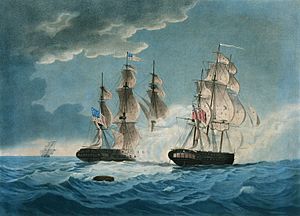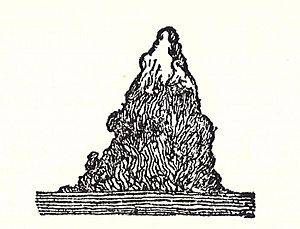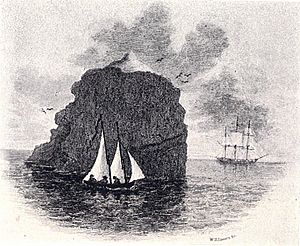HMS Endymion (1797) facts for kids

HMS Endymion (right) exchanges broadsides with USS President (left)
|
|
Quick facts for kids History |
|
|---|---|
| Name | Endymion |
| Operator | Royal Navy |
| Ordered | 30 April 1795 |
| Builder | John Randall & Co, Rotherhithe |
| Laid down | November 1795 |
| Launched | 29 March 1797 |
| Commissioned | 12 June 1797 |
| Reclassified | Re-rated as 50-gun fourth rate in 1817 |
| Stricken | 1859, Receiving ship |
| Honours and awards |
Naval General Service Medal with clasps: "8 April Boat Service 1814", "Endymion wh. President" |
| Fate | Broken up in Plymouth, 18 June 1868 |
| General characteristics | |
| Class and type | Endymion-class frigate |
| Tons burthen | 1,277 bm |
| Length | 159 ft 3 in (48.5 m) |
| Beam | 42 ft 7 in (13.0 m) |
| Draught | 15 ft 8 in (4.8 m) |
| Propulsion | Sail |
| Speed | |
| Complement | 300, increased to 340 during the War of 1812 |
| Armament |
|
HMS Endymion was a famous British warship, known as a 40-gun fifth rate frigate. She served in many important wars, including the French Revolutionary Wars, the Napoleonic Wars, the War of 1812, and the First Opium War.
This ship was built like a captured French ship called Pomone. Pomone was known for being very fast. Because Endymion handled so well and sailed incredibly fast, other ships were later built based on her design.
Endymion became especially famous for her battle with the American ship USS President in 1815. In this fight, Endymion caught and badly damaged the American frigate. This led to President being captured a few hours later. Endymion was also known as one of the fastest sailing ships in the Royal Navy during the Age of Sail. She could sail at 14.4 knots (26.7 km/h) when running with the wind and nearly 11.0 knots (20.4 km/h) when sailing against it.
Her last active duty was during the First Opium War, where she took part in operations on the Yangtze river. In 1859, she became a receiving ship, which is like a floating barracks. She was finally taken apart in June 1868.
Throughout her career, Endymion was praised for how well she sailed. This made her a highly desired ship for frigate captains to command. Even in the 1830s, long after her war service, she was still seen as the best example for Royal Navy frigates. She could even outsail much newer ships.
Contents
Battles in the French Revolutionary Wars
In April 1797, Captain Thomas Williams took command of Endymion. Her first duties were patrolling the English Channel and the Irish coast. In October, Endymion joined the North Sea fleet. She was ordered to chase Dutch ships after the Battle of Camperdown. Endymion quickly found a Dutch warship, Brutus, close to shore. However, the Dutch ship was in a protected area and managed to escape.
For the next three years, Captain Williams and Endymion patrolled off Ireland and escorted convoys to St Helena. In early 1798, Endymion captured four privateer ships near the Irish coast. Privateers were private ships allowed by a government to attack enemy shipping.
- The French schooner Revanche, with 12 guns and 88 men.
- The French privateer lugger Brutus, with six guns and 50 men.
- The Spanish schooner St. Antonia, carrying important messages from Havana. Her crew tried to sink the messages, but Endymion's crew retrieved them.
- The French privateer ship Huit Amis, with twenty guns and 160 men. This ship was brand new and very fast. The Royal Navy later used her as HMS Bonetta.
In September 1798, Endymion captured or recaptured three more ships:
- Britannia, a British merchant ship that had been captured by a French privateer.
- Sophie, a French privateer of 20 guns and 130 men. She was known for being very fast and had escaped British warships eight times. The Royal Navy later used her as HMS Sophie.
- May Flower, an American ship captured by a French privateer.
Between late 1799 and May 1800, Endymion captured several more French and Spanish privateers and merchant ships.
- The Spanish privateer lugger Saint Joseph, with four guns and 38 men.
- The Spanish lugger privateer Intripido, with two guns and 21 men.
- The French merchant ship Paix, with ten guns and 44 men. She was carrying cargo from Nantes.
- The privateer ship Scipio, with eighteen guns and 149 men. She was very new and sailed extremely fast. Lieutenant Charles Austen (brother of famous author Jane Austen) led a small boat in a storm to board and capture Scipio.
In November 1799, Endymion was escorting a group of ships from India. A strong storm scattered the convoy. One merchant ship, Bhavani, was wrecked on the French coast. Some of her crew died, but others were captured by the French.
In February 1800, Endymion and HMS Amazon recaptured Trelawney, a British merchant ship. Amazon also captured the French privateer Bougainville, which then sank. Most of her crew were saved.
In 1801, Captain Williams left Endymion to command a larger ship. Captain Philip Charles Durham took over.
Napoleonic Wars and the War of 1812
When war started again in 1803, Endymion joined the British fleet that was blocking the French port of Brest. She stayed there until 1805. During these years, Endymion captured many French and Spanish ships. These included merchant ships, privateers, and even some smaller warships.
In June 1803, Endymion and Dragon captured the French warship Colombe. The Royal Navy later used her as HMS Colombe. Seven days later, Endymion captured the French warship Bacchante after an eight-hour chase. Bacchante had 18 guns and 200 men. She lost eight men killed and nine wounded trying to escape. The Royal Navy also took her into service as HMS Bacchante.
In July 1803, Endymion stopped the British merchant ship Culland's Grove. Captain Charles Paget, who was commanding Endymion, took 12 sailors from Culland's Grove. This was allowed by law at the time, as the Royal Navy needed more men.
In autumn 1805, Endymion joined Vice Admiral Nelson's fleet off Cadiz. This fleet was blocking the French and Spanish forces. On October 2, Nelson sent Endymion and five other ships to Gibraltar for supplies. Because of this, Endymion missed the famous Battle of Trafalgar on October 21.
In 1807, Endymion took part in the Dardanelles Operation. She sailed to Constantinople with the British ambassador for talks with the Ottoman Empire. The mission failed. When the British fleet sailed back through the Dardanelles, Turkish shore batteries attacked them. Endymion suffered three men killed and nine wounded. From 1808 onwards, Endymion served in British home waters, where she captured more French privateers.
Exploring Rockall Island
In August 1810, Endymion, along with HMS Princess Charlotte, sailed to the remote islet of Rockall. This tiny island was not well-known at the time. T. Harvey, Endymion's master, recorded its position.
The first time anyone landed on Rockall from Endymion was on Sunday, September 8, 1811. Captain Sir William Bolton was in command. One of the lieutenants on board was Basil Hall, who was part of the landing party.
In July 1811, Endymion was again near Rockall. By September 8, she returned. The landing started quite casually. Lieutenant Basil Hall wrote in his book, "As we had nothing better on our hands, it was resolved to make an exploring expedition to visit this little islet." Two boats were prepared, and artists and geologists got ready for a "grand scientific field day."
The sea was unusually calm that day, but large waves made landing difficult. The crew had to be very brave to jump ashore. They made observations and measurements. Then, a fog appeared. They worried about losing sight of Endymion and started to return to the ship. The waves made getting back into the boats hard, taking half an hour. By then, Endymion was lost in the fog.
One person was sent back to the rock to climb it and look for the ship. He saw an approaching fog bank, which could last for days. Luckily, the ship was sighted. After another delay to get their "shivering scout," they rowed after the ship. But the fog returned, and they had to go back to Rockall again. They started planning to stay on the island, even though they had no food or fresh water. They decided to abandon one boat and drag the other ashore for shelter. Fortunately, the fog suddenly lifted, and they saw the ship again. They finally returned to Endymion almost dark, five or six hours after the fog first appeared.
Basil Hall was not the only one in the landing party, but he was the only one to write about it. Because of his account, the large ledge near the top of Rockall, where a flagpole was later put up, was named "Hall's Ledge."
In November 1810, Endymion captured the 14-gun privateer Milan.
Service in North America
In 1812, Endymion underwent major repairs in Plymouth. She was ready in July 1813. Two more 32-pounder carronades were added to her weapons, and her crew increased to 340 men. She was then sent to North America, where she captured some American privateers. Her crew also used boats to attack American ships.
Endymion's boats tried to capture the famous American privateer Prince de Neufchatel. However, they were not successful. Endymion lost over 100 men killed, wounded, or captured in this attempt.
In December 1813, Endymion and Pomone captured the American merchant ship John and James. In January 1814, Endymion captured another American merchant ship, Felicity, set her on fire, and sank her.
In March 1814, Endymion, Belvidera, and Rattler captured the American privateer Mars, which had 15 guns and 70 men. In April 1814, boats from Endymion and other ships attacked Pettipague point. Later, a special medal was given to those who survived this action. In August 1814, Endymion and Armide captured the American privateer Herald. Later in 1814, Endymion joined the ships blocking the port of New York.
In August, Endymion took part in an expedition up the Penobscot River in Maine. The goal was to capture the American frigate Adams. Adams had taken refuge upriver and set up guns on the bank. British forces moved up the river for two days. After a battle, the British captured the American defenders. The Americans burned Adams to prevent her capture. The British also captured or destroyed 17 other ships. The British lost only one man killed.
The Famous Battle with USS President
On January 14, 1815, USS President, commanded by Commodore Stephen Decatur, left New York. She was on a mission to the Indian Ocean. She soon met a British squadron of ships. This group included the large Majestic (56 guns), Endymion (Captain Henry Hope), Astrée (38 guns), and Tenedos (38 guns).
The British ships immediately started chasing President. Endymion, being much faster, soon left her squadron behind. By 2 PM, she caught up to President. Endymion positioned herself behind President and fired into her as the American ship tried to escape. Endymion was able to fire three "raking" shots, which means firing along the length of the enemy ship, causing a lot of damage. President, on the other hand, mainly aimed at Endymion's rigging (sails and ropes) to try and slow her down.
Finally, at 7:58 PM, President stopped firing and showed a light, meaning she had surrendered. Endymion's foresails were damaged, so she stopped to repair them. Because of this, she couldn't immediately take control of President. While Endymion was busy with repairs, Commodore Stephen Decatur, despite having surrendered, tried to escape at 8:30 PM. Endymion quickly resumed the chase at 8:52 PM.
At 9:05 PM, Pomone and Tenedos caught up with the badly damaged President. Not knowing that President had already surrendered, Pomone fired two broadsides (all guns on one side) into President. After this, Decatur surrendered his ship again. Captain Lumley of Pomone then took control of President.
British reports said President lost 35 men killed and 70 wounded, including Decatur. American sources reported 24 killed and 55 wounded. Endymion had 11 killed and 14 wounded. In 1847, a special medal was given to surviving crew members of Endymion for this battle.
There has been a long debate about which ship truly won the battle. President could not fight a normal duel because other British ships were coming. Her only hope was to damage Endymions rigging to escape, but she failed. Endymion, though smaller, managed to slow down and damage the American frigate. She fired three raking broadsides that caused many casualties and forced President to surrender. Endymion disabled six of Presidents guns and hit many gunports. Shots from Endymion even pierced President below the waterline, causing water to enter her hold.
However, some say President had actually disabled Endymion and removed her from the chase. They claim President only surrendered when Pomone and Tenedos arrived. This uncertainty was present even at the time. Commodore Decatur himself made different statements. In a British court, he said his sword should go to the captain of "the black ship" (Endymion), as he had surrendered to her alone. But in his later report for Americans, he changed this statement.
There was also discussion about how many of President's casualties were caused by Pomones broadsides. Before Pomone fired, President was already heavily damaged on the side Endymion had attacked. Pomone attacked the other side, and little damage was recorded there. Witnesses from President later said that Pomones shots caused no new casualties, mainly because they were poorly aimed and many American sailors were below decks.
Comparing the Ships (Using English measurement methods for both ships)
| HMS Endymion | USS President | |
|---|---|---|
| Length (gundeck) | 159 ft 3 in (48.54 m) | 173 ft 3 in (52.81 m) |
| Beam | 42 ft 7 in (12.98 m) | 44 ft 4 in (13.51 m) |
| Tonnage | 1277 tons (bm) | 1533 tons (bm) |
| Crew | 346 men | at least 450 men |
| Armament | 26 × 24-pounder, 20 × 32-pounder carronades 1 × 18-pounder |
32 × 24-pounder 20 × 42-pounder carronades 1 × 24-pounder howitzer |
| Broadside weight | 641 lb (291 kg) | 816 lb (370 kg) |
Later Years and Fate
After the War of 1812, Endymion was kept in reserve until 1833. From 1840 to 1842, she served in the fleet commanded by Sir William Parker during the First Opium War. This war involved operations on the Yangtze river in China.
In December 1846, she rescued eight crew members from USS Somers. Somers had been wrecked off Vera Cruz, Mexico, while blocking that port. In 1859, Endymion became a receiving ship in Plymouth. She was finally taken apart in June 1868.
Commanding Officers
The captains who commanded Endymion were:
- 1797 Captain Sir Thomas Williams
- 1801 Captain Philip Charles Durham
- 1803 Captain Hon. Charles Paget
- 1805 Captain Edward Durnford King
- 1806 Captain Thomas Bladen Capel
- 1810 Captain Sir William Bolton
- 1813 Captain Henry Hope
- 1833 Captain Sir Samuel Roberts
- 1840 Captain Hon. Frederick Grey
- 1845 Captain George Lambert




